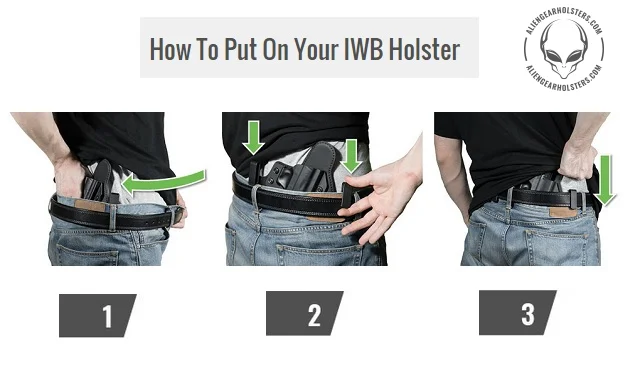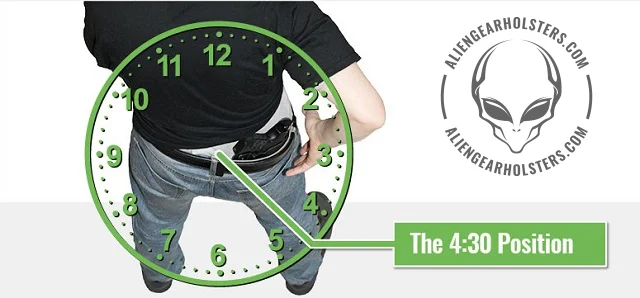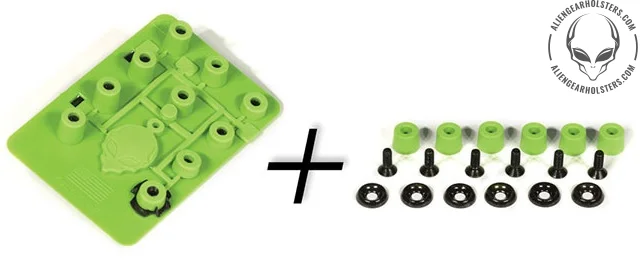
How To Wear An IWB Holster
The IWB holster design is the standard for concealed carry, as this type of holster is the easiest to conceal. Provided good design and construction, it's also one of the most comfortable.
Trust us, we know; IWB holsters are some of our best-selling products!
But how to wear an inside-the-waistband holster? Plenty of people over the years have discovered that it isn't as easy as just sliding the holster inside the waistband and taking off. There are a few subtleties to using this piece of carry equipment that you should be aware of.
We're going to show you how to wear an IWB holster, starting with how to put one on, get it adjusted so you can carry and conceal comfortably, and how to dial the holster in so you can carry how you want to.
Putting On Your IWB Concealed Carry Holster
The first part, of course, is putting on your IWB concealed carry holster.
The installation procedure depends greatly on the holster you're wearing. Some holsters are designed for easy installation, even some IWB holsters. The idea is to just slide it inside the waistband and go. However, what a lot of people find is that holster designs of that type don't retain the gun very well - often the only thing keeping the gun inside the thing is your belt - and with larger guns, puts a lot of weight in one spot.
That's why the "winged" IWB holster design is so prevalent. It works better! The weight of the pistol is spread over a larger area and the holster holds the gun in by virtue of having its own passive retention. The side effect is that it's a bit trickier to install.
We suggest that the first time you put on your holster, do so without your gun inserted in the holster. This will give you a good feel for it.

- Undo your belt
- Unfasten your waist button or waist tab.
- Slide the holster behind your waistband until you reach the right carry position
- Slide the belt clips over your belt
- Fasten your waistband and belt
For the first few times you put on your holster, do it in front of a mirror.
Once you've gotten your hand in, so to speak, you can start putting on the holster with your pistol inserted. Don't think you have to, though; some people find it works better for them when they put the holster on and insert their handgun afterward. Usually you'll have to adjust your waistband or belt a bit, but no big deal.
What Are The IWB Concealed Carry Positions?

The IWB concealed carry positions are the spots around the waistline where a person puts their gun and holster. There is some differing nomenclature regarding them, but there's a pretty easy one to remember.
What's that, you ask?
Well...it's pretty simple. Since people have kind of a round shape, the easiest guide to the concealed carry positions is to use the hour marking on a clock. The point of each hip is 3 o'clock and 9 o'clock; the middle of your back is 6 o'clock and your belly button is at 12 o'clock.
Here's a bit of a visual reference.
For the Alien Gear Cloak Tuck (and many others), you may need to loosen or adjust the sleeve prior to inserting the firearm. We'll cover the adjustment portion and walk you through that process.
Adjusting Your Inside The Waistband Holster Retention
You might find that you need to loosen or adjust the holster retention shell on your inside the waistband holster prior to inserting the firearm.
With some IWB holsters, the factory settings on the hardware - be they Chicago screws, hex screws, grommets or the Adjustable Retention Unit on the ShapeShift 4.0 IWB - may be incredibly tight or incredibly loose, depending on the holster in question.
How can you tell when you get it?
Unload and clear your pistol, and try to insert it into the holster. If it goes in without issue, and you can draw it without the draw feeling like the gun came out too easily or with more effort than you think it should, the holster is fine. If holstering or drawing is too easy or too tough, then you should make an adjustment.
For instance, if you need to adjust your Cloak Tuck 3.0 holster, use the included Allen wrench to slowly loosen the hex bolts that anchor the retention shell. Back out the bolts or tighten them in small increments; don't use more than a half-turn at a time. Test each new setting by holstering and drawing your pistol from the holster until you've reached the desired setting.
If you're carrying with the ShapeShift 4.0 IWB holster, use the included twist lock nut to adjust the Adjustable Retention Unit until you reach the desired setting.

Adjusting The Cant Of The Inside The Waistband Holster
Once you've determined the correct positioning and the right amount of tension, you may want to experiment with adjusting the cant. To do this, for the Alien Gear Cloak Tuck, simply adjust the two clasps. You can use the Allen wrench to unscrew them and then place them up or down respectively depending upon how you want your pistol grip to face.

The procedure is a little different for the 4.0 IWB holster. Instead of hex bolts and T-nuts, the 4.0 IWB uses a locking cam on the holster clip itself and a shaft insert in the holster backer. To adjust the cant and/or ride height, you rotate the clip until it's facing down, and pry out the camshaft. Seat it in the desired shaft and rotate until the cam locks in place - it's that simple.
Grip cant and height adjustment may be necessary to find a carry position for your pistol that feels comfortable to you. Some people prefer a higher ride height, some people prefer lower; some people prefer an aggressive forward tilt and others like a straight drop.
Part of Alien Gear Holsters' design philosophy is customizability. We give you the ability to reconfigure the holster so you can carry it how you want to, not how it's set from the factory. Have a look at our line of IWB holsters and discover just how comfortable concealed carry can get.
 |
About The Author Born in southeastern Washington State, Sam Hoober graduated in 2011 from Eastern Washington University. He resides in the great Inland Northwest, with his wife and child. His varied interests and hobbies include camping, fishing, hunting, and spending time at the gun range as often as possible. |








